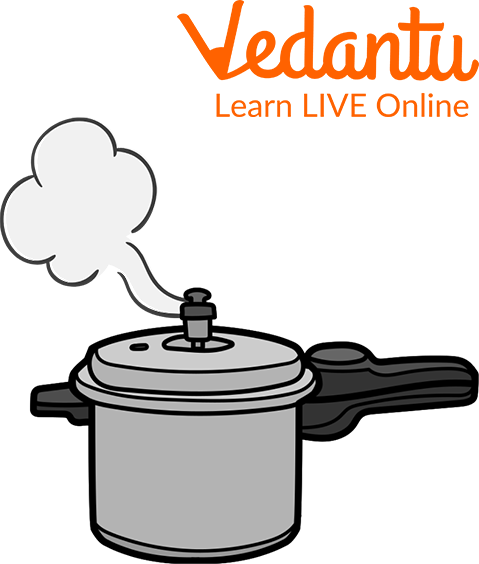




Overview of Boiling Melting Points
Kids, imagine there is a Girl named Anna who went on a summer vacation with her family to the Maldives. The weather was extremely hot so Anna asked her mum to make her some ice cream. She then took her ice cream and went into the park in the hot sun. Anna noticed that the ice cream started to melt. What did we learn from this? we learned the concept of melting.
Melting is a point where a solid substance turns into a liquid when heated. Imagine there is a grandma who keeps water to boil on the stove. After a few minutes, grandma notices vapour coming out from the bowl. Boling is a point when a liquid starts to boil when heated. Let's further understand the concept of melting and boiling point in this article.

Melting of Ice Cream and Boiling of Water
What is the Boiling Point of Water?
The Boiling point of water is 100 ° C Or 212 ° F. The value does not remain the same; it depends on the open atmospheric pressure. This pressure changes according to changes in the heat. If you increase the temperature by applying more heat to the container then the temperature rises. If you then lower the heat pressure then the atmospheric pressure reduces leading to a lower temperature.
Similarly, the quality of the water also affects its boiling point. The boiling point of impure water (such as salty water) is higher than that of clean water. We refer to this as a rise in the boiling point or elevation.
Example of Increase in Boiling Point
We use a pressure cooker for cooking food because it utilizes less time to cook food. It is one of the most common examples of a Boiling point. When we place water into the cooker and let it boil after a few minutes we see the vapour coming out from the cooker through the whistles. This is because when we apply heat the temperature rises to lead to vapour trapping which further leads to increased pressure in the cooker that is why cooking gets faster using a cooker.

Pressure Releasing From Cooker
What is the Melting Point of Water?
Melting point refers to the transformation of a solid into a liquid. Adding heat to a solid cause it to melt. By doing this, the particle's molecules become more active and start to vibrate. As a result of all this jiggling around, the molecules in the material are unable to cling to one another as tenaciously as they do in the solid phase; consequently, they separate, and the substance transitions to the liquid state.
The temperature at which water transforms from solid ice to liquid water is known as the melting point. At this temperature, the solid and liquid states of water are equal. There isn't a single temperature that can be regarded as the melting point of water because the melting point partly depends on pressure. However, for practical purposes, 0°C, or 32 °F or 273.15 K, is quite close to being the melting point of pure water ice at 1 atmosphere of pressure.
How does Melting Happen?
To melt a substance, heat can be applied slowly or rapidly. We simply have to transfer the ice cubes from a cooler to a warmer setting; this will result in the melting of the ice water present in the glass. This process can take longer if we place the ice water glass in the refrigerator as the temperature inside is lower when compared to the kitchen counter. However, if we had placed the glass and ice cubes in a hot oven, the ice would just have melted considerably more quickly due to the significantly higher temperature of the oven compared to the kitchen. Apart from this melting point of water also depends on the substance itself to understand this let's take an example.
Example of Melting Point
Let us say there are 2 different substances frozen at -25 degrees in the refrigerator. The first glass contains water and the second glass contains olive oil. At -25 degrees both these substances are solid. If we turn the refrigerator off the olive oil starts melting at 20 degrees Celsius. But the ice remains the same. As we increase the temperature to 0°C the ice starts to melt. This means that the melting point of water is 0°C Why did this happen? It is because different substances require different levels of heat to melt. Some substances like aluminium require a heat level of 660°C to melt while silver requires 1550° C to melt.
Difference Between Melting and Boiling Point
The differences are as follows:
Summary
In this article, we learned that a boiling point is a temperature at which the vapour pressure is equal to the surrounding pressure. We learned how the surrounding pressure and vapour pressure are proportionate. Through the example of a pressure cooker, we learned the concept of boiling point. Further, we got to know about the Boiling point of water and how temperature varies as per the applied Pressure. Further, we learned about a melting point which is the temperature at which the solid turns into liquid, and how melting depends upon the temperature at which the substance is kept. We hope you enjoyed reading this article, in case of any other doubts, feel free to ask in the comments.
FAQs on Melting and Boiling Points
1. What are the definitions of melting point and boiling point in Science?
The melting point is the specific temperature at which a substance changes its state from a solid to a liquid at atmospheric pressure. The boiling point is the temperature at which a liquid turns into a gas (or vapour) when heated at atmospheric pressure. Both are unique physical properties used to identify substances.
2. What is the standard melting point and boiling point of water?
For pure water at standard atmospheric pressure (1 atm), the melting point is 0° Celsius (32° Fahrenheit or 273.15 Kelvin). The boiling point of water under the same conditions is 100° Celsius (212° Fahrenheit or 373.15 Kelvin).
3. Is there a difference between melting point and freezing point?
For a pure substance, the melting point and freezing point are the same temperature. The key difference lies in the process being described. Melting point refers to the temperature during the transition from solid to liquid, while freezing point refers to the temperature during the transition from liquid to solid. Heat is absorbed during melting and released during freezing.
4. Why is the boiling point of a substance almost always higher than its melting point?
The boiling point is higher because changing from a liquid to a gas requires significantly more energy than changing from a solid to a liquid. During melting, energy is needed only to loosen the bonds holding particles in a fixed lattice. For boiling, energy must be sufficient to completely overcome the intermolecular forces of attraction, allowing particles to escape into the gaseous phase, which demands a much higher energy input and thus a higher temperature.
5. What is the role of latent heat in melting and boiling?
Latent heat is the hidden energy absorbed or released during a phase change without changing the substance's temperature. Latent heat of fusion is the energy absorbed to change a solid into a liquid at its melting point. Latent heat of vaporization is the energy absorbed to change a liquid into a gas at its boiling point. This energy is used to break intermolecular bonds, which is why the temperature remains constant during the entire melting or boiling process.
6. What external factors can change the melting or boiling point of a substance?
Two primary factors can influence these points:
- Pressure: An increase in external pressure typically raises the boiling point (e.g., a pressure cooker cooks food faster by raising water's boiling point). It has a minor effect on the melting point for most substances.
- Impurities: Adding impurities (like salt to ice) generally lowers the melting point/freezing point. Dissolving a non-volatile substance (like salt in water) will elevate the boiling point.
7. How do melting and boiling points determine if a substance is a solid, liquid, or gas at room temperature?
By comparing a substance's melting and boiling points to room temperature (approx. 25°C), we can determine its state:
- If the melting point is above room temperature, the substance is a solid (e.g., iron, with MP of 1538°C).
- If the melting point is below room temperature and the boiling point is above it, the substance is a liquid (e.g., water, with MP 0°C and BP 100°C).
- If the boiling point is below room temperature, the substance is a gas (e.g., oxygen, with BP of -183°C).
8. Can the air we breathe be frozen into a solid?
Yes, air can be frozen, but it requires extremely low temperatures not found naturally on Earth. Air is primarily a mixture of nitrogen (~78%) and oxygen (~21%). Oxygen freezes at -218°C (-361°F) and nitrogen freezes at -210°C (-346°F). To freeze air, you would need to cool it below these temperatures, at which point it would turn into a solid block.









